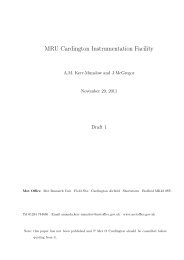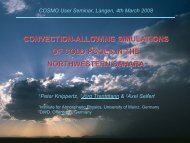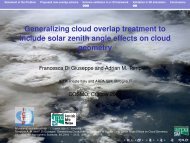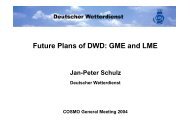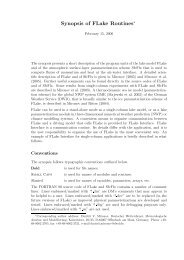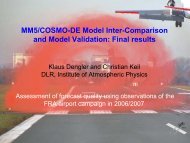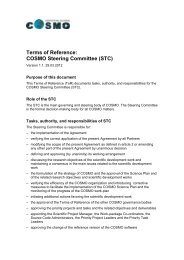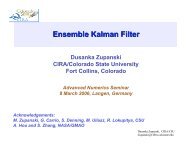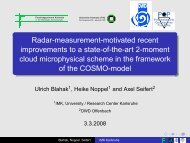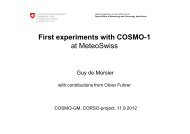document - Cosmo
document - Cosmo
document - Cosmo
Create successful ePaper yourself
Turn your PDF publications into a flip-book with our unique Google optimized e-Paper software.
1 Working Group on Data Assimilation 25<br />
Ground clutter can be considered as one of the most important source of non-rain echoes,<br />
most of which is eliminated by appropriate clutter filters. However, in order to minimise<br />
eliminating real rain echoes, MeteoSwiss’ clutter filter, for instance, leaves some 2% of the<br />
non-rain echoes in the data (Germann and Joss, 2004). This residual clutter often manifests<br />
as small-scale, quasi-static, medium to high intensity signals. On the basis of this, ground<br />
clutter is modeled for the purposes of this study as isolated, one-pixel signals of varying<br />
intensities I f. These signals are assimilated during forcing times of various length (t f). The<br />
boundary layer humidity was varied to obtain environments of various degrees of instability<br />
(see Tab. 1). An NWP model’s numerical diffusion scheme is designed to act strongly upon<br />
one-pixel signals so that results obtained by these experiments can be taken as lower limits<br />
of the respective impact. I.e. in reality, and for larger non-rain echo areas, the impacts are<br />
expected to be more pronounced than what results from these experiments.<br />
A large number of of experiments, i.e. 125, have been conducted, varying the clutter intensity<br />
I f = 2, 5, 10, 20, 30, 50, 60 mm/h, the forcing times t f from 2 min up to 2 hours. The<br />
varying degree of instability with the boundary layer moisture content results in differing<br />
lifting condensation levels and levels of free convection. Often, these levels are lower for<br />
environments of larger instabilities.<br />
rmax CAPE LCL LFC<br />
( g/kg) ( J/kg) ( m) ( m)<br />
10 400 1630 2840<br />
11 800 1450 2400<br />
12 1200 1290 2040<br />
13 1700 1130 1730<br />
14 2200 990 1470<br />
Table 1: Specifications of the environments used for the numerical experiments. Values<br />
include the maximum water vapour mixing ratio in the boundary layer, CAPE,<br />
lifting condensation level and level of free convection.<br />
3 Results<br />
3.1 Description of a single experiment<br />
Figure 1b,c) summarises the outcome of two individual experiments both conducted in a<br />
1700 J/kg CAPE atmosphere, with a 10 mm/h clutter forced during 20 min (solid lines in<br />
panel b) and 6 min (dashed line). The model response to the applied forcing is depicted<br />
in terms of maximum up- and downdraft (panel b) and total accumulated precipitation<br />
(panel c). The larger forcing causes an updraft which reaches a strength of 1 m/s after about<br />
7 min. Continuing the forcing out to 20 min does not increase the vertical velocity, but keeps<br />
it at this level even though a slight modulation is visible, indicating an interaction between<br />
the forcing and the developing model dynamics. However, after having switched off the<br />
forcing air parcels seem to have reached the level of free convection sometime between 20<br />
and 30 min. Once this level is reached the instability present in the basic state is released,<br />
exhibiting values of the vertical velocity up to 13 m/s at t = 52 min. Substantial rain falls<br />
out beginning at t = 41 min. and stops when the system relaxes at t = 60 min. Total rainfall<br />
accumulates close to 0.1 · 10 6 m 3 whereas the precipitation equivalent of the forcing amounts<br />
to 0.01·10 6 m 3 , i.e. the error given by the non-rain echo has been amplified by the assimilation<br />
COSMO Newsletter No. 6




